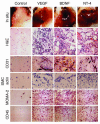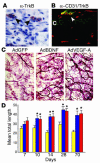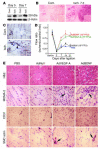Neurotrophins promote revascularization by local recruitment of TrkB+ endothelial cells and systemic mobilization of hematopoietic progenitors
- PMID: 15765148
- PMCID: PMC1051987
- DOI: 10.1172/JCI22655
Neurotrophins promote revascularization by local recruitment of TrkB+ endothelial cells and systemic mobilization of hematopoietic progenitors
Abstract
The neurotrophin brain-derived neurotrophic factor (BDNF) is required for the maintenance of cardiac vessel wall stability during embryonic development through direct angiogenic actions on endothelial cells expressing the tropomysin receptor kinase B (TrkB). However, the role of BDNF and a related neurotrophin ligand, neurotrophin-4 (NT-4), in the regulation of revascularization of the adult tissues is unknown. To study the potential angiogenic capacity of BDNF in mediating the neovascularization of ischemic and non-ischemic adult mouse tissues, we utilized a hindlimb ischemia and a subcutaneous Matrigel model. Recruitment of endothelial cells and promotion of channel formation within the Matrigel plug by BDNF and NT-4 was comparable to that induced by VEGF-A. The introduction of BDNF into non-ischemic ears or ischemic limbs induced neoangiogenesis, with a 2-fold increase in the capillary density. Remarkably, treatment with BDNF progressively increased blood flow in the ischemic limb over 21 days, similar to treatment with VEGF-A. The mechanism by which BDNF enhances capillary formation is mediated in part through local activation of the TrkB receptor and also by recruitment of Sca-1+CD11b+ pro-angiogenic hematopoietic cells. BDNF induces a potent direct chemokinetic action on subsets of marrow-derived Sca-1+ hematopoietic cells co-expressing TrkB. These studies suggest that local regional delivery of BDNF may provide a novel mechanism for inducing neoangiogenesis through both direct actions on local TrkB-expressing endothelial cells in skeletal muscle and recruitment of specific subsets of TrkB+ bone marrow-derived hematopoietic cells to provide peri-endothelial support for the newly formed vessels.
Figures







Comment in
-
Pleiotropy of tissue-specific growth factors: from neurons to vessels via the bone marrow.J Clin Invest. 2005 Mar;115(3):596-8. doi: 10.1172/JCI24511. J Clin Invest. 2005. PMID: 15765145 Free PMC article.
Similar articles
-
Paracrine and autocrine functions of brain-derived neurotrophic factor (BDNF) and nerve growth factor (NGF) in brain-derived endothelial cells.J Biol Chem. 2004 Aug 6;279(32):33538-46. doi: 10.1074/jbc.M404115200. Epub 2004 May 28. J Biol Chem. 2004. PMID: 15169782
-
Combination of stromal-derived factor-1alpha and vascular endothelial growth factor gene-modified endothelial progenitor cells is more effective for ischemic neovascularization.J Vasc Surg. 2009 Sep;50(3):608-16. doi: 10.1016/j.jvs.2009.05.049. Epub 2009 Jul 12. J Vasc Surg. 2009. PMID: 19595531
-
Brain-derived neurotrophic factor increases vascular endothelial growth factor expression and enhances angiogenesis in human chondrosarcoma cells.Biochem Pharmacol. 2014 Oct 15;91(4):522-33. doi: 10.1016/j.bcp.2014.08.008. Epub 2014 Aug 19. Biochem Pharmacol. 2014. PMID: 25150213
-
Efficient mobilization and recruitment of marrow-derived endothelial and hematopoietic stem cells by adenoviral vectors expressing angiogenic factors.Gene Ther. 2002 May;9(10):631-41. doi: 10.1038/sj.gt.3301723. Gene Ther. 2002. PMID: 12032709 Review.
-
Brain-derived neurotrophic factor: a newly described mediator of angiogenesis.Trends Cardiovasc Med. 2007 May;17(4):140-3. doi: 10.1016/j.tcm.2007.03.002. Trends Cardiovasc Med. 2007. PMID: 17482097 Free PMC article. Review.
Cited by
-
Tumor-induced neurogenesis and immune evasion as targets of innovative anti-cancer therapies.Signal Transduct Target Ther. 2020 Jun 18;5(1):99. doi: 10.1038/s41392-020-0205-z. Signal Transduct Target Ther. 2020. PMID: 32555170 Free PMC article. Review.
-
Pleiotropy of tissue-specific growth factors: from neurons to vessels via the bone marrow.J Clin Invest. 2005 Mar;115(3):596-8. doi: 10.1172/JCI24511. J Clin Invest. 2005. PMID: 15765145 Free PMC article.
-
Developmental diversity and unique sensitivity to injury of lung endothelial subtypes during postnatal growth.iScience. 2023 Jan 31;26(3):106097. doi: 10.1016/j.isci.2023.106097. eCollection 2023 Mar 17. iScience. 2023. PMID: 36879800 Free PMC article.
-
Inhibitory effect of miR‑182‑5p on retinal neovascularization by targeting angiogenin and BDNF.Mol Med Rep. 2022 Feb;25(2):61. doi: 10.3892/mmr.2021.12577. Epub 2021 Dec 22. Mol Med Rep. 2022. PMID: 34935052 Free PMC article.
-
Novel Evidence of the Increase in Angiogenic Factor Plasma Levels after Lineage-Negative Stem/Progenitor Cell Intracoronary Infusion in Patients with Acute Myocardial Infarction.Int J Mol Sci. 2019 Jul 6;20(13):3330. doi: 10.3390/ijms20133330. Int J Mol Sci. 2019. PMID: 31284593 Free PMC article.
References
-
- Carmeliet P. Mechanisms of angiogenesis and arteriogenesis. Nat. Med. 2000;6:389–395. - PubMed
-
- Yancopoulos GD, et al. Vascular-specific growth factors and blood vessel formation. Nature. 2000;407:242–248. - PubMed
-
- Cao R, et al. Angiogenic synergism, vascular stability and improvement of hind-limb ischemia by a combination of PDGF-BB and FGF-2. Nat. Med. 2003;9:604–613. - PubMed
-
- Aicher A, et al. Essential role of endothelial nitric oxide synthase for mobilization of stem and progenitor cells. Nat. Med. 2003;9:1370–1376. - PubMed
Publication types
MeSH terms
Substances
Grants and funding
LinkOut - more resources
Full Text Sources
Other Literature Sources
Medical
Research Materials

